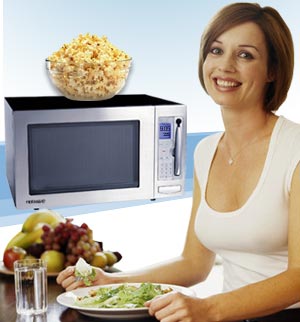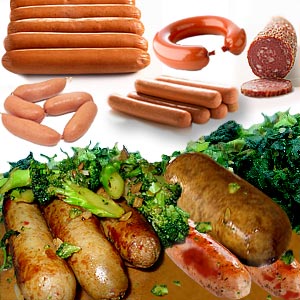Microwave Cooking

The microwave oven is now an essential part of most kitchens. In many a household, microwave cooking is restricted to heating coffee, making popcorn or melting butter. Microwave ovens work well for defrosting, heating and cooking. You can whip up tasty dishes and save food from losing nutrients as well as protect the color and flavors. There is much controversy over the harmful effects of microwave cooking.
As per World Health Organization (WHO) guidelines, microwave ovens are safe, provided the manufacturer's instructions are clearly followed. Food cooked in the microwave oven is as nutritious as food cooked in other ways and studies suggest that microwave cooking retains more vitamins, minerals and nutrients than boiling. However, the danger lies when the microwave ovens are not used correctly. Learn valuable safety tips for microwave cooking. Find out how to keep your microwave clean.
Microwave cooking
Microwave ovens for household cooking typically operate at a frequency of 2450 megahertz in a continuous wave (cw) mode. The magnetron tube is the source for the radiation waves. This energy moves around the oven capacity through a wave guide section and is spread evenly in the oven with a mode stirrer. Microwaves make water molecules wiggle and thus produce heat. In this way, the microwave oven does not heat up. More vitamins and minerals are retained with microwave cooking than with many other methods of cooking. This is because microwave cooking requires a shorter cooking time.
Foods with high water content cook well with microwave ovens. But beware of cold spots. Cold spots are areas where the food does not get hot enough to kill bacteria. This can be avoided by periodic stirring and rotation. When microwaving food partly done to finish cooking on the grill or conventional oven, transfer the microwaved food to another heat source at once. Listed below are some of the common misconceptions regarding microwave cooking:
Microwave energy changes the chemical composition of food
Microwaves are high frequency radio waves that form a part of the electromagnetic spectrum. These waves are absorbed by materials containing water such as foods, fluids or tissue that absorbs microwave energy and convert them to heat energy. Microwave energy does not create any poisonous or dangerous compounds.
Eating food cooked in the microwave exposes you to radiation
Though it is obvious and known that microwave ovens use microwave radiation to cook food, they do not cause any hazards when eaten. Microwaves generated in microwave ovens cease to exist once the electrical power is turned off. They do not stay in food once the power is switched off. Neither can they make the food or the oven radioactive. Therefore, food cooked in microwave oven is not a radiation hazard.
You can heat just about anything in a microwave oven
Do not use the microwave for heating a baby's bottle. It could result in the liquid becoming extremely hot and scalding the baby's mouth. The buildup of steam in a closed container such as a baby's bottle could cause it to explode. Never use the microwave for drying clothing or other items. It is a fire hazard. Do not use the microwave oven for deep frying or canning. To test if a glass container is suitable for microwave cooking, microwave it with some water for a minute. If the container has become warm, do not use it for cooking. If the container is lukewarm, use it for reheating. Use the glass container for cooking if it is cool even after a minute in the microwave.
Microwave Oven Safety
Microwave ovens are designed to ensure that microwaves are contained within the oven and can only be present when the oven is switched on and the door is shut. However leakages are possible when the oven is damaged. It is therefore important to maintain the microwave oven in a good condition always. Check that the door closes properly and the safety interlock devices work correctly. Keep the door seals clean and ensure that there is no damage to the door and the outer casing of the oven.
In case of any damage, get it repaired or serviced by an appropriately qualified service engineer before using it again. Persons with pacemaker implants should not be near a microwave oven unless they are sure that it is in good operating condition and there is no leakage of microwave radiation. Do not permit young children to operate the oven.
- Do not operate a microwave oven when it is empty because microwaves may damage the cavity. It is advisable to leave a cup of water inside the oven in case of an accidental start.
- Check to see that door seal and inside surfaces of door and oven cavity are clean after each use.
- Do not put face close to door window when oven is operating.
- Never use the microwave for drying clothing or other items.
- Since microwaves cannot pass through metal, do not use metals utensils for microwave cooking. Microwaves bounce off metal, which can cause arcing and a fire inside the oven. Use glass, glass ceramic cookware that is labeled for microwave cooking use. Do not use gold or silver trimmed dishes.
- Use oven pads when removing utensils from the microwave oven.
Microwave cooking tips
Food safety is an important health issue. At times food is heated unevenly as a result of cold spots and hot spots. This can lead to health risks if parts of the food are not heated sufficiently to kill potential micro-organisms. Use the following safe microwaving tips to prevent food-borne illness.
- Arrange food items evenly in a covered dish and add some liquid if needed. Even cooking bags and lids can help ensure even cooking and destruction of harmful bacteria.
- Do not cook large cuts of meat on a high power. Cook them instead on medium power for longer periods. This allows heat to reach the center without overcooking the outer areas.
- Stir or rotate food midway through the microwaving time to eliminate cold spots where harmful bacteria can survive.
- Use food thermometer or the oven's temperature probe to verify whether the food has reached a safe temperature.
- Avoid cooking stuffed poultry, as it is hard to ensure the stuffing has reached a temperature high enough to kill harmful bacteria.
- Remove the food from packages before defrosting and never use foam trays or plastic wraps. They don't have the capacity to withstand high temperatures. Plastic wraps may melt and cause chemicals to migrate into the food.
- Cook meat, poultry, egg casseroles and fish immediately after defrosting in the microwave oven. Some areas of the frozen food may begin to cook during the defrosting time.
- If you have covered the food during cooking, ensure that there is a small vent so that there is no steam build up.
- Use a dish twice the size of the ingredients you have put in to avoid spillage.
- Pierce hot dogs and baking potatoes with a fork before putting them into the microwave oven to keep them from exploding.
- De-bone large pieces of meat. Bone can shield the meat around it from thorough cooking.
- Turn large food items upside down so foods cook more evenly and safely.
Microwave Oven cleaning
Microwave ovens are simple to clean. All you need is water and dish washing detergent. Once done, wipe off the excess crumbs and pieces from the microwave's interior. Use paper towels to wipe off raw meat, fish or poultry juices. Discard the paper towels after cleaning. Wash the inner trays with dish soap, dry and return them to the oven. Clean the exterior of parts with a gentle cleanser.
Don't clean the exterior if the oven interior is hot. The heat will quickly evaporate the cleaning solution. Ensure that you do not damage any of the exterior surface while cleaning. Do not use abrasive or harsh cleaners or scouring pads. Never spray oven cleaners directly onto any part of the oven. If you want to remove odors, clean the microwave interiors with a solution of baking soda and warm water.
Top of the Page: Microwave Cooking
Tags:#microwave cooking #microwave cooking tips #microwave cleaning
 Food and Nutrition Facts
Food and Nutrition Facts Chamomile
Parsnip Soup
Dim Sum
Gazpacho Soup
Whole Grain Cereal
Jicama Nutrition
Bok Choy Stir Fry
Chia Seeds Benefits
Teff Nutrition
Kaniwa
Flax Seed
Wheatgrass Benefits
Kelp Benefits
Types of Chili Peppers
Medicinal Benefits of Pomegranate
Arugula Leaves
Maca Root
Pitaya Fruit
Benefits of Celery
Leek
Asparagus Benefits
Oyster Stew
Oyster Mushroom
Lupin Beans
Quinoa
Freekeh
Extra Virgin Olive Oil
Dill Pickle
Sauerkraut
Fat Burning Foods
Nutrition Chart
Food Combining
Calorie Counter
calories ...
Non Alcoholic Beverage
Punch Recipes
Food Label Nutrition
Homemade Sausages
Cooking Steak
Eating on a Budget
Budget Friendly Recipes
Quick Recipes
 Healthy Packed Lunch
Healthy Packed Lunch Overnight Oats Recipes
Eggplant Casserole
Brunch Recipes
Burrito Recipes
Muffin Recipes
Cupcake Frosting
Apple Crisp
Stir Fry Cooking
Seafood Salad Recipe
Cooking Corn on the Cob
Finger Food Recipe
Sandwich Recipe
Bread Stuffing Recipes
Easy Chili Recipes
Picnic Recipes
Edible Mushroom Recipes
Mushroom Soup Recipes
Dip Recipe
Tapas Recipe
Corned Beef Recipe
Canned Salmon Recipe
Tilapia Recipes
Crumb Cake
Flourless Chocolate Cake
Regional Food
 Lasagna Recipe
Lasagna Recipe Peruvian Ceviche
Chinese Food Recipe
Vietnamese Food Recipe
Malaysian Food
Korean Food Recipe
Indian Curry Recipe
Edible Rice Paper
Mexican Food Recipe
Quesadilla
Guacamole Dip
Italian Food Recipe
Spanish Food Recipe
Kosher Food
Falafel Recipe
Tandoori Chicken
Noodles
Canape
Couscous
Meatloaf
Chowder
Gumbo Recipe
Crockpot Recipes
Moroccan Food
Healthy Food
Pre Workout Snack
Matcha Tea
Simple food Swaps to Lose Weight
Foods to Beat Stress
Foods to beat Insomnia
Bone Density Foods
Prebiotic Foods
Kefir Grains
Agave Nectar
Spicy Trail Mix
Pesto Sauce
Homemade Hummus
Crab Cake Sauce
Bamboo Shoots Nutrition
Lemon Grass Plant
Butter Beans Recipes
Loose Green Tea
Seaweed Nutrition
Healthy Food
Low Fat Granola Bar
Steel Cut Oatmeal
Fruit Pizza
Pizza Toppings
Green Smoothie
Healthy Meal Planning
Delicious Mealtime Recipes
Heart Healthy Fats
Healthy Heart Recipe
Healthy Dinner Recipe
Healthy Dessert Recipe
Healthy Fast Food
Healthy Kid Recipe
Probiotic Food
Diabetic Friendly Foods
Fruit Salad Recipe
Bread Pudding
Tofu Recipe
Oat Bran
Broccoli Salad
Avocado Recipe
Iron Rich Food
Brain Foods
Antioxidant Food
Natural Diuretic
Low Fat Cooking Tips
Rice Pilaf Recipe
Low fat Chicken Recipe
Food Tips

Sous Vide Cooking Technique
Natural Sugar Substitute
Stevia Sugar Substitute
Sunflower Seeds Nutrition
Bouquet Garni
Cake Decorating Tips
High Satiety Foods
Thanksgiving Dinner
Safe Food Storage
Frozen Food Storage Tips
Cold Storage Food Tips
Leftover Recipe
Food Pyramid
Dairy Free Food
Microwave Cooking
Food Intolerance
Homemade Ice Cream
Apple Cider Vinegar
Benefits of Honey
Beverage Cooler
Food Poisoning Symptom
Food Allergy Symptom
Food Addiction
Top of the Page: Microwave Cooking
Popularity Index: 101,346

